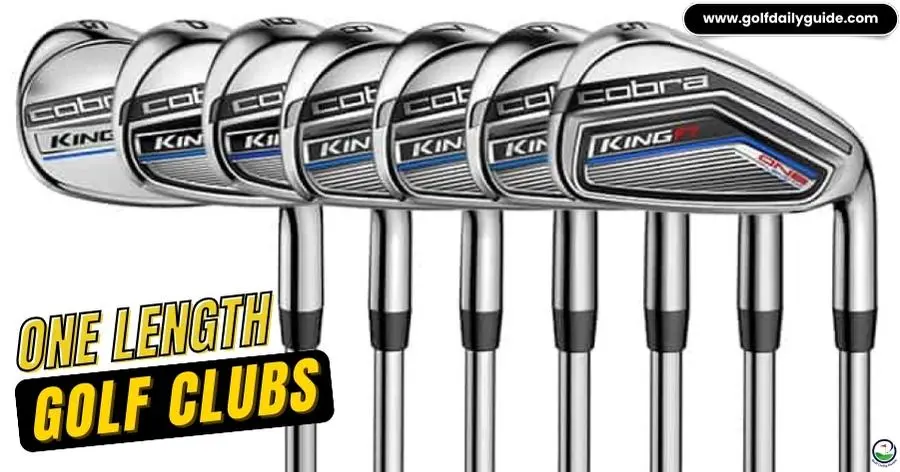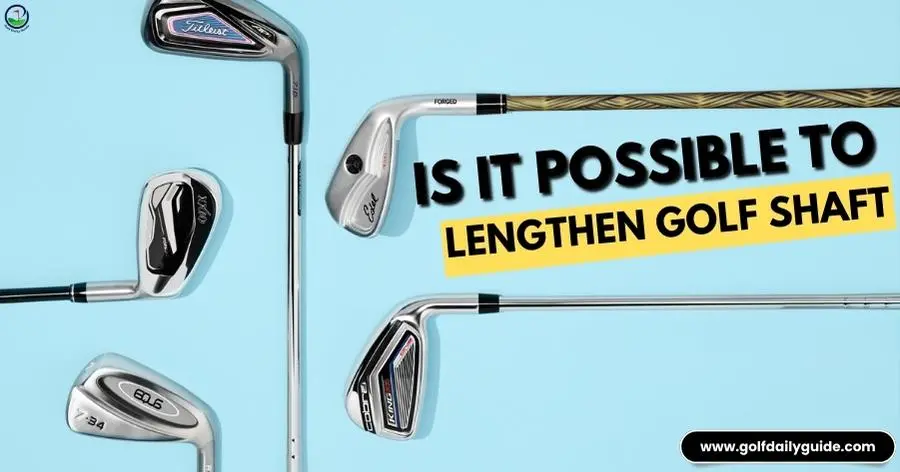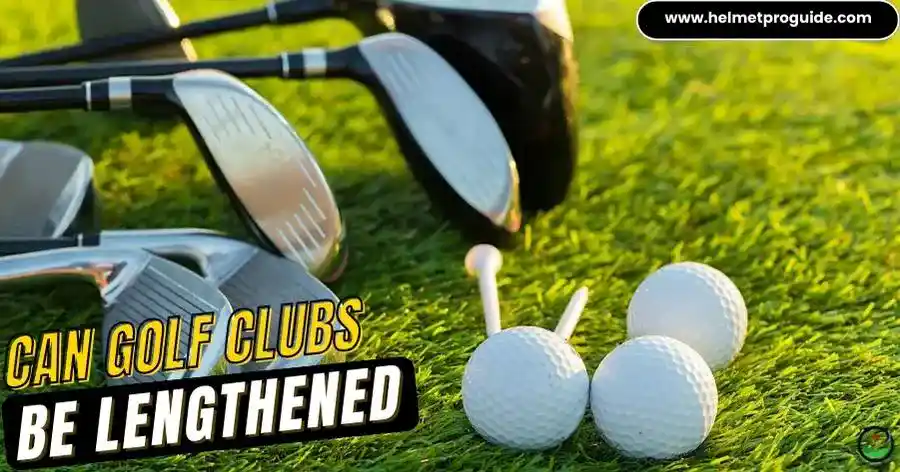Generally, a game of golf, accuracy and techniques, often related to the primitive fairware image and carefully related to manicure greens. However, there is a complex world of equipment design and engineering on the back of the clean.
One of the most interesting aspects of the golf clubs is their different length, made to serve a specific purpose in each course.
Have you ever wondered that why are golf clubs different lengths? Or why do your putter have so many different feelings from your pitching wage?
In this article, we discover interesting reasons behind this difference in the length of the golf club, unveiling each club as an essential tool in the arsenal of the golfer.
Why are golf clubs different lengths?
Golf clubs vary in length to optimize performance for different types of shots and distances. The lengths are designed to suit the specific requirements of each club’s intended use.
For example, drivers have longer shafts to generate more clubhead speed and maximize distance off the tee.
Fairway woods and hybrids are slightly shorter for better control, allowing players to hit shots off the fairway or rough with accuracy.
Irons gradually decrease in length from the longer irons (2-iron) to the shorter ones (9-iron) to provide a balance between distance and control. Shorter clubs, like wedges, enable precision shots around the green.
Overall, the varying lengths help golfers achieve the right balance of power, accuracy, and consistency across their entire set of clubs.
1. Importance Of Club Length
Golf clubs come in different lengths to suit different swing styles and body types. Longer clubs can provide more distance, while shorter clubs offer better precision, essential for closer shots.
Understanding the importance of club length can help golfers maximize their performance and improve their game.
2. Impact On Performance
The length of a golf club plays a crucial role in determining a player’s performance on the course.
Being properly fitted for the right club length can greatly impact various aspects of a golfer’s game, including distance, accuracy, and shot consistency.
When it comes to distance, the length of the golf club directly affects how far the ball will travel.
Longer clubs will typically generate more clubhead speed, resulting in greater distance off the tee or fairway.
On the other hand, shorter clubs are designed for more precision. The closer you are to the hole, the more precise you want to be with your shots.
The accuracy of a golfer’s shots is heavily influenced by the club length as well. Using a club that is too long or too short can lead to inconsistent ball striking and off-center hits.
A club that is too long may cause the player to lose control, while a club that is too short can cause them to lean forward and make poor contact with the ball.
3. Effect On Swing Mechanics
The length of a golf club also has a significant impact on a player’s swing mechanics. The optimal club length allows for a comfortable and balanced swing, promoting better tempo and rhythm.
A club that is too long may require the golfer to reach too far during the backswing, leading to a loss of control and balance.
On the other hand, a club that is too short can cause the player to stand too upright and restrict their range of motion, resulting in a lack of power and control.
Swing speed is another important factor affected by club length. Using a club that is too long or too short can disrupt the natural flow of the swing and reduce clubhead speed.
A properly fitted club length allows the golfer to generate maximum clubhead speed and achieve optimal distance and accuracy.
What does one length golf clubs mean?
One-length golf clubs refer to a set of golf clubs where all the irons have the same shaft length, lie angle, and weight.
This is in contrast to traditional sets where each iron has a progressively longer shaft. The concept, popularized by Bryson DeChambeau, aims to provide a consistent swing feel for all irons, simplifying the swing mechanics.
With one-length clubs, golfers can use a uniform setup and posture, promoting greater shot consistency and easier club transition.
However, this approach may not suit everyone, as players have varying preferences and swing dynamics that influence club performance.
One Length Golf Clubs
Golf clubs are different lengths to serve different purposes on the golf course. Longer clubs, like drivers, provide more distance, while shorter clubs, like wedges, offer more precision.

Varying club lengths help golfers achieve optimal clubhead speed and ensure proper yardage gaps between clubs.
1. Understanding The Concept
One Length Golf Clubs, as the name suggests, are golf clubs that are all the same length. Unlike traditional golf clubs where each club has a different length, the One Length concept promotes consistency and simplicity in a player’s swing.
With One Length clubs, the length of the 7-iron is used as the standard length, and all other clubs, including the driver and the wedges, are adjusted to match that length.
2. Benefits And Drawbacks
One Length Golf Clubs offer several benefits to golfers:
- Consistency: One Length clubs promote consistency in a player’s swing and ball striking. By having clubs of the same length, golfers can develop a repeatable swing motion, resulting in more consistent shots.
- Simplicity: With One Length clubs, there is no need to adjust your setup or swing for each different club. This simplicity can make the game easier and less complicated.
- Improved Ball Striking: Golfers who struggle with ball striking may find that One Length clubs help them strike the ball more solidly. The consistent length of the clubs can lead to better timing and contact.
However, it’s important to consider the potential drawbacks of using One Length Golf Clubs:
- Limited Shot Variety: One Length clubs may limit the ability to hit different types of shots, such as high-trajectory shots or low-trajectory shots. The consistent length may not provide the necessary versatility in certain situations.
- Distance Control: Some golfers may find it challenging to control the distance with One-length clubs, as the club lengths traditionally associated with longer distances are not present in this setup.
- Adjustment Period: Switching from traditional clubs to One-length clubs may require an adjustment period. Golfers may need to spend time getting used to the new feel and setup of the clubs.
Ultimately, the decision to use One Length Golf Clubs or traditional clubs depends on individual preference and playing style.
It’s important to try out different club options and assess which setup suits your game the best.
Why Are Golf Clubs Progressively Shorter?
Golf clubs are progressively shorter to accommodate the different demands of various shots and provide optimal performance.
Longer clubs, like drivers, generate more clubhead speed for maximum distance off the tee. As clubs get shorter, starting with fairway woods and progressing to irons, control becomes a priority, allowing for precision in different situations.
Shorter clubs, such as wedges, facilitate accuracy and finesse around the green. The length variation helps golfers strike a balance between power and control, adapting to the diverse challenges presented by the varying distances and shot requirements on a golf course.
Factors To Consider
The length of golf clubs plays a crucial role in a golfer’s performance, as it directly impacts their swing mechanics and overall game.
Several factors need to be considered in determining the appropriate club length for a player, including their height, swing mechanics, and adherence to a proper club fitting guide.
Let’s explore these factors in detail:
1. Player’s Height
The height of a player significantly influences the appropriate length of golf clubs. Taller players generally require longer clubs to match their extended reach, while shorter players are better suited to shorter clubs for better control and comfort during the swing.
Finding the right club length based on the player’s height is crucial for achieving optimal balance and accuracy in their shots.
2. Swing Mechanics
The unique swing mechanics of each player must be taken into account when determining the ideal club length.
Factors such as swing plane, tempo, and posture play a vital role in selecting the appropriate club length.
A thorough assessment of the player’s swing mechanics will help in identifying the right club length that complements their individual swing style and ensures consistent performance on the course.
3. Club Fitting Guide
Following a comprehensive club fitting guide is essential for determining the ideal golf club length for a player.
Professional club fitting involves assessing various aspects, including the player’s height, wrist-to-floor measurement, and swing characteristics.
Utilizing the guidance of a club fitting professional or utilizing innovative fitting technologies can aid in selecting the perfect club length based on individual player requirements, resulting in improved accuracy and distance control.
Is it possible to lengthen golf shaft?
Yes, it is possible to lengthen a golf shaft, but it should be done carefully by a professional club fitter or a skilled technician.

Lengthening a golf shaft involves adding an extension to the existing shaft, typically at the butt end. While this can increase the club’s overall length, it may affect the club’s swing weight and balance.
It’s essential to consider the potential impact on the golfer’s swing dynamics and performance.
Additionally, lengthening a shaft beyond a certain point can alter the club’s characteristics, potentially leading to unintended consequences, so any adjustments should be made with a thoughtful understanding of the player’s needs and preferences.
Choosing The Right Length
Golf clubs are different lengths to optimize performance and accuracy. Longer clubs generate more power for long-distance shots, while shorter clubs offer precision for shorter shots near the hole.
Varying club lengths help golfers achieve the desired clubhead speed and proper distance gaps.
1. Impact Of Arm Length
Arm length plays a crucial role in determining the ideal length for your golf clubs. If your arms are longer or shorter than average, using standard clubs may affect your swing, resulting in inconsistent shots and reduced accuracy.
Longer arms may require longer clubs to maintain a proper grip and address the ball comfortably, while shorter arms may benefit from shorter clubs to achieve better control and shot accuracy.
2. Club Length Guidelines
When selecting the right length for your golf clubs, there are a few guidelines to keep in mind:
- Height: Your height is a key factor in determining the ideal club length. Taller golfers may require longer clubs, while shorter golfers may find shorter clubs more suited to their swing.
- Arm Length: As mentioned earlier, your arm length should be considered when choosing golf club length. Longer arms generally pair well with longer clubs, while shorter arms may benefit from shorter clubs.
- Swing Style: Your swing style and technique may influence the club length that works best for you. Golfers with a smoother, more controlled swing may prefer shorter clubs for enhanced precision. On the other hand, golfers with a more aggressive, powerful swing may find longer clubs provide more distance.
- Comfort: Ultimately, the right club length is one that feels comfortable and allows you to maintain proper posture and balance during your swing. Comfort is essential for consistency and optimal performance on the golf course.
Remember, it’s always recommended to get fitted by a professional golfer or visit a club fitting facility to ensure the clubs you choose are well-suited to your unique body characteristics and swing style.
This will help maximize your potential and enjoyment on the golf course.
By taking into account your arm length, height, swing style, and comfort, you can confidently choose the right club length that enhances your performance and brings you closer to achieving your golfing goals.
Can golf clubs be lengthened?
Yes, golf clubs can be lengthened by adding an extension to the shaft. This process is typically performed by a professional club fitter or a skilled technician.
The extension is inserted into the butt end of the shaft, effectively increasing the overall length of the club.
However, it’s crucial to consider the potential effects on swing weight and balance. Lengthening a club may alter its characteristics and impact a golfer’s performance.

Careful adjustments and consideration of the player’s swing dynamics are essential to ensure the modified clubs suit the golfer’s preferences and maintain optimal performance.
1. Comparison Of Club Lengths
Golf clubs come in different lengths to cater to various player heights, swing styles, and distances to the hole.
Longer clubs provide greater distance and speed, ideal for long-range shots, while shorter clubs are designed for precision and control, perfect for closer, accurate shots.
The flexibility in club lengths ensures players can choose the right tool for the job, improving their performance on the course.
Golf clubs come in various lengths, each serving a distinct purpose on the course.
Understanding the differences between club lengths can greatly impact your performance and overall game.
In this section, we will compare the precision vs. distance and the effect on swing speed when it comes to golf club lengths.
2. Precision Vs. Distance
When it comes to precision and accuracy, shorter clubs are designed to excel. These clubs, such as wedges and irons, provide the control needed for shots that require finesse and accuracy, especially when you’re approaching the green.
The shorter length allows for better control over the swing and enables players to make more precise shots.
Whether you’re trying to avoid hazards or place the ball exactly where you want it, shorter clubs are your best bet.
On the other hand, longer clubs are primarily focused on distance. Drivers and fairway woods are specifically designed to maximize the power and distance of your shots off the tee or on the fairway.
The longer shafts and larger club heads generate greater clubhead speed, resulting in increased distance. If you’re looking to hit the ball farther down the fairway or tee off with maximum power, longer clubs are your go-to.
3. Effect On Swing Speed
The length of a golf club can significantly impact your swing speed. Longer clubs, with their extended shafts, naturally increase the arc and momentum of your swing.
This allows players to generate more speed, resulting in greater distance when striking the ball. The longer the club, the more time it takes to swing, allowing for increased inertia and a more powerful strike.
Conversely, shorter clubs have a shorter shaft length, resulting in a shorter swing arc. This may translate into slower swing speeds compared to longer clubs.
However, the shorter swing arc provides greater control and precision, allowing players to focus on accuracy rather than raw power:
| Club Type | Precision | Distance | Swing Speed |
| Shorter Clubs | ✓ | Slower | |
| Longer Clubs | ✓ | Faster |
Understanding the differences between club lengths and their effects on precision, distance, and swing speed is crucial in selecting the right club for each shot.
Choosing the appropriate club length for each situation can greatly improve your overall performance on the course.
Frequently Asked Questions On Why Are Golf Clubs Different Lengths
How Do I Choose The Right Golf Club Length?
To choose the right golf club length, consider your height and arm length. If the club feels too long, it may be harder to control. If it feels too short, you may be leaning too far forward. Stand with feet shoulder-width apart and arms naturally at your sides to test the fit.
How Do You Size Golf Clubs For Your Height?
To size golf clubs for your height, follow these guidelines:
- Stand with your feet shoulder-width apart and let your arms hang naturally at your sides.
- Measure the distance from your wrist to the ground.
- Use a club fitting chart or consult a professional to find the appropriate club length for your height.
- Consider the flex and lie angle of the clubs as well.
- Test the clubs for comfort and performance before making a final decision.
How Do I Know If My Golf Clubs Are Too Short?
If your golf clubs feel too long, you may have trouble controlling them or making solid contact with the ball. If they feel too short, you may be leaning too far forward. To check, set up a ball with feet shoulder-width apart and arms hanging naturally at your sides.
Do Mens Golf Clubs Come In Different Lengths
Yes, mens golf clubs come in different lengths to suit the height and swing characteristics of individual players. Varying club lengths helps optimize performance and ensure proper clubhead speed for better ball contact and distances.
Related Post
How much does a new golf cart cost
My Golf Cart Won’t Go But is Fully Charged
How long do golf cart batteries typically last
Do golf courses close when it rains
What happens if your golf shaft is too stiff
Conclusion
In conclusion, the varying lengths of golf clubs are designed to accommodate the different distances and angles required for different shots on the golf course.
Each club is carefully constructed to maximize performance and accuracy for specific situations, such as hitting long drives or making precise approach shots.
By understanding the purpose behind each club’s length, golfers can better appreciate the thought and strategy that goes into designing a set of clubs.
So next time you’re out on the course, take a moment to consider how the unique lengths of your clubs enhance your game and enable you to play your best.












